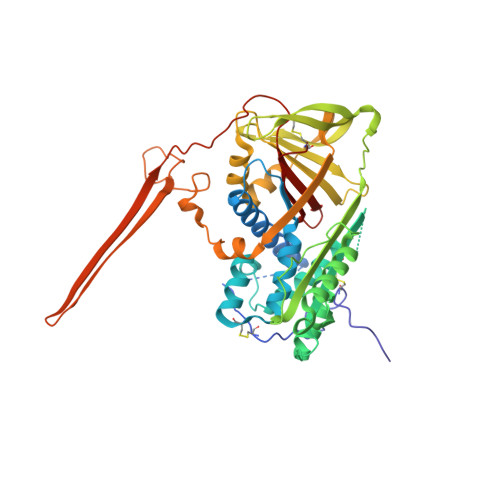Crystal structure of a stable dimer reveals the molecular basis of serpin polymerization
Yamasaki, M., Li, W., Johnson, D.J., Huntington, J.A.(2008) Nature 455: 1255-1258
- PubMed: 18923394
- DOI: https://doi.org/10.1038/nature07394
- Primary Citation of Related Structures:
2ZNH - PubMed Abstract:
Repeating intermolecular protein association by means of beta-sheet expansion is the mechanism underlying a multitude of diseases including Alzheimer's, Huntington's and Parkinson's and the prion encephalopathies. A family of proteins, known as the serpins, also forms large stable multimers by ordered beta-sheet linkages leading to intracellular accretion and disease. These 'serpinopathies' include early-onset dementia caused by mutations in neuroserpin, liver cirrhosis and emphysema caused by mutations in alpha(1)-antitrypsin (alpha(1)AT), and thrombosis caused by mutations in antithrombin. Serpin structure and function are quite well understood, and the family has therefore become a model system for understanding the beta-sheet expansion disorders collectively known as the conformational diseases. To develop strategies to prevent and reverse these disorders, it is necessary to determine the structural basis of the intermolecular linkage and of the pathogenic monomeric state. Here we report the crystallographic structure of a stable serpin dimer which reveals a domain swap of more than 50 residues, including two long antiparallel beta-strands inserting in the centre of the principal beta-sheet of the neighbouring monomer. This structure explains the extreme stability of serpin polymers, the molecular basis of their rapid propagation, and provides critical new insights into the structural changes which initiate irreversible beta-sheet expansion.
Organizational Affiliation:
University of Cambridge, Department of Haematology, Cambridge Institute for Medical Research, Wellcome Trust/MRC Building, Hills Road, Cambridge CB2 0XY, UK.


















